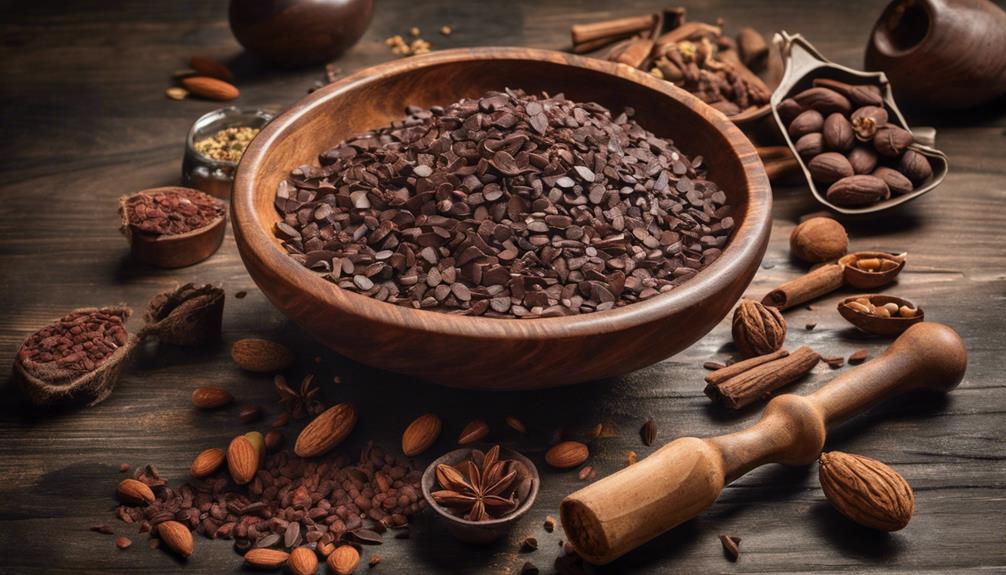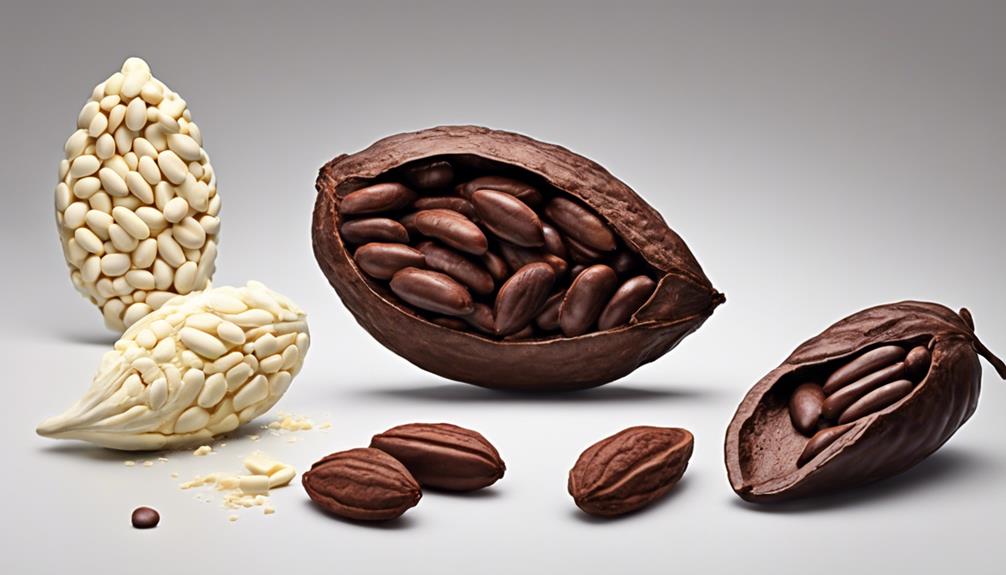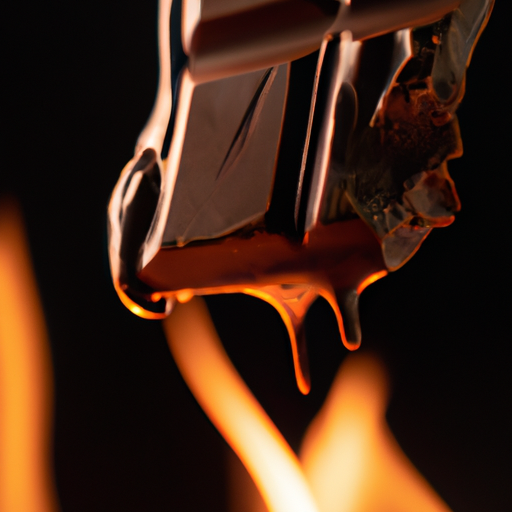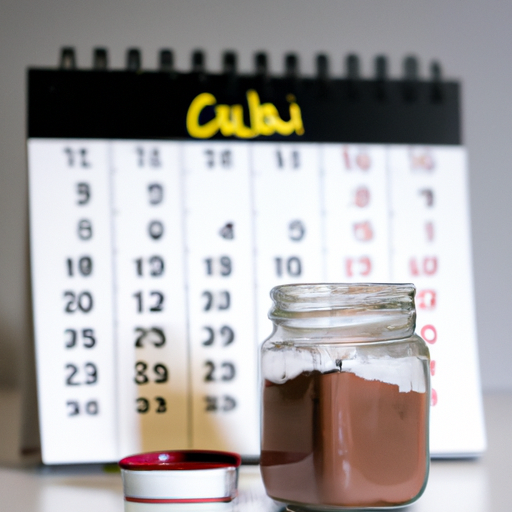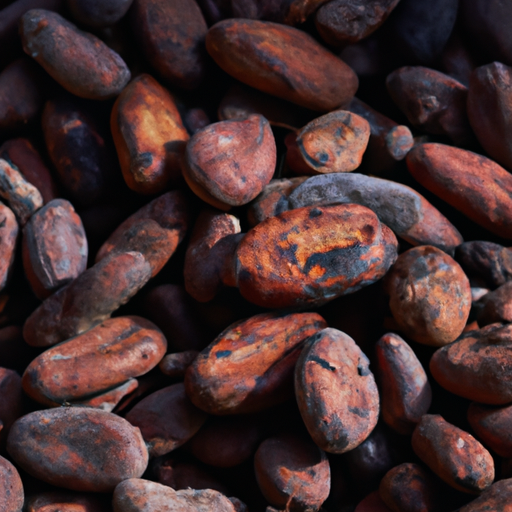When cooking with cacao nibs, the options are limitless. I can’t wait to share some delicious recipe ideas with you! For breakfast, consider sprinkling cacao nibs on top of smoothie bowls or mixing them into pancake batter. Sweet treats become even more enjoyable with cacao nibs in rich chocolate desserts. In savory dishes, enhance the flavors by incorporating these nibs into fresh goat cheese or onto spiced lamb sausage pizza. And don’t forget to experiment with beverage choices such as customizing hot cocoa drinks with sweeteners and spices.
For guilt-free snacking, incorporate cacao nibs into energy bars or protein balls for a satisfying crunch. Each bite promises a burst of rich antioxidants and fiber, transforming every meal into a wholesome indulgence.
Key Takeaways
- Cacao nibs elevate breakfast by adding rich chocolate flavor to smoothie bowls, pancake batter, overnight oats, yogurt, and fruit bowls.
- Create decadent sweet treats by incorporating cacao nibs into chocolate desserts, combining well with coconut, nuts, and fruit.
- Enhance savory dishes with intense chocolatey taste by sprinkling cacao nibs on fresh goat cheese, duck breast, calamari, or pizza.
- Customize beverages like hot cacao drinks and smoothies with cacao nibs for a nutrient-packed and flavorful option.
- Enjoy guilt-free snacks by adding cacao nibs to energy bars or protein balls for a satisfying crunch rich in antioxidants and nutrients.
Breakfast Ideas
When starting the day, I often enjoy incorporating cacao nibs into my breakfast recipes for a nutritious and flavorful boost. Cacao nibs are small pieces of crushed cacao beans that add a rich, chocolatey taste to my morning meals. I love sprinkling them over my smoothie bowls or mixing them into my pancake batter for that extra crunch and burst of flavor. These little nibs aren't only delicious but also packed with antioxidants and fiber, making them a great choice for a healthy breakfast.
In addition to smoothie bowls and pancakes, I also like to include cacao nibs in my overnight oats. The texture they provide is fantastic, and the subtle bitterness complements the sweetness of the oats perfectly. Sometimes, I even add them to my yogurt or sprinkle them over my fruit bowl for a delightful twist. Starting the day with cacao nibs not only adds a delicious touch to my breakfast but also helps me kickstart my morning with a nutritious boost.
Sweet Treats
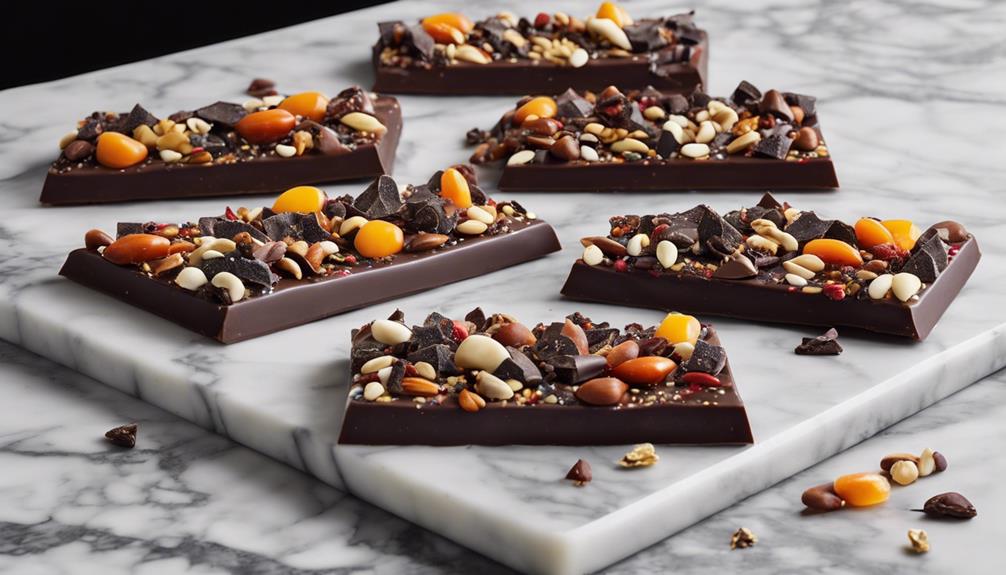
Let's talk about some scrumptious sweet treats that you can make with cacao nibs.
Get ready to indulge in decadent chocolate desserts, whip up some easy cacao nib cookies, and bake irresistible cocoa brownies.
These recipes are sure to satisfy your sweet tooth and impress your friends with the rich, bitter cocoa flavor of cacao nibs.
Decadent Chocolate Desserts
Indulge in a world of decadent chocolate desserts with the addition of cacao nibs for a rich and satisfying treat.
When cacao nibs are incorporated into desserts, they bring a deep, intense chocolate flavor and a delightful crunch to every bite.
The versatility of cacao nibs allows them to be paired with ingredients like coconut, nuts, and fruit, creating a wide array of sweet treats that cater to your cravings.
Whether it's indulging in chocolate ganache tarts or biting into banana doughnuts, the addition of cacao nibs elevates the texture and taste of these sweet delights.
Get ready to experience a symphony of flavors with each decadent chocolate dessert infused with the goodness of cacao nibs.
Easy Cacao Nib Cookies
Savor the delectable essence of cacao nibs in these irresistible easy cookies, perfect for a sweet treat anytime. These cookies boast a crunchy texture and a rich, chocolatey flavor that will leave you craving for more. Here's a simple recipe to create your own batch of delicious cacao nib cookies:
| Ingredients | Instructions | Tips |
|---|---|---|
| 1 cup flour | Preheat oven to 350°F | Use high-quality cacao nibs for intense flavor |
| 1/2 cup butter | Mix flour, butter, and sugar | Add a sprinkle of sea salt for a flavor contrast |
| 1/2 cup sugar | Fold in cacao nibs | Let the cookies cool on the baking sheet for a chewy center |
| 1/4 cup cacao nibs | Form cookie dough balls | Enjoy with a glass of cold milk |
These cookies are a delightful way to enjoy the unique taste of cacao nibs in a simple and satisfying treat.
Irresistible Cocoa Brownies
I can't resist the temptation of these irresistible cocoa brownies; they're a sweet treat worth savoring. When cocoa nibs make their way into brownies, they bring a depth of flavor that elevates the chocolate experience.
Here's why you should indulge in these decadent delights:
- Cocoa brownies are rich and decadent, with intense chocolate flavor from cacao nibs.
- The cacao nibs add a satisfying crunch and depth of flavor to traditional brownie recipes.
- Incorporating cacao nibs into brownies provides a unique texture and enhances the overall chocolate experience.
- These brownies not only taste amazing but also offer a boost of antioxidants and nutrients, making them a gourmet and healthier dessert option.
Savory Creations
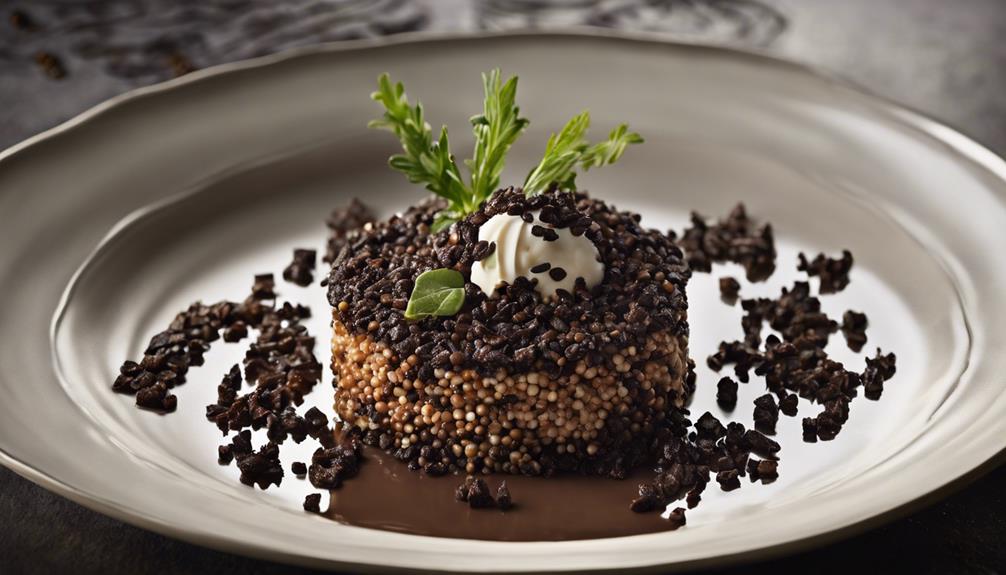
Cacao nibs can elevate the savory aspect of dishes by providing a rich and intense chocolatey flavor profile when paired with ingredients like fresh goat cheese or used in recipes such as shallot and beer marmalade. The combination of the slightly bitter cocoa nibs with the creamy tang of goat cheese creates a delicious contrast that tantalizes the taste buds. Below is a table showcasing some savory creations that benefit from the addition of cacao nibs:
| Savory Dish | Ingredients | Benefits |
|---|---|---|
| Duck Breast | Cacao Nibs, Red Wine Reduction, Rosemary | Adds depth and richness to the dish |
| Fried Calamari | Cacao Nibs, Lemon Zest, Garlic Aioli | Provides a unique chocolatey crunch |
| Spiced Lamb Sausage Pizza | Cacao Nibs, Feta Cheese, Arugula | Offers a hint of bitterness and crunch |
These dishes demonstrate the versatility of cacao nibs in savory recipes, enhancing flavors and textures in unexpected yet delightful ways.
Beverage Delights
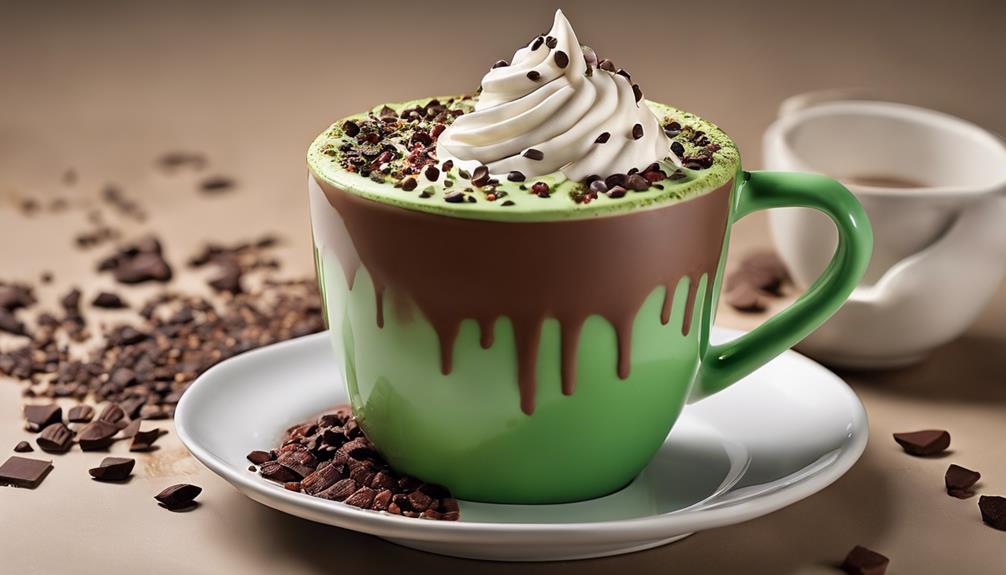
When it comes to beverage delights with cacao nibs, there are exciting options to explore.
Hot cacao drinks offer a cozy and chocolatey experience perfect for chilly days.
Cacao smoothie recipes provide a nutritious and indulgent way to start your day with a burst of flavor.
Hot Cacao Drinks
Indulge in the velvety warmth of a steaming cup of hot cacao bliss, enveloping you in a cocoon of chocolatey comfort.
Experience the rich, chocolatey taste of cacao nibs melting into the hot milk, creating a luxurious and indulgent treat.
Customize your drink by adding sweeteners and spices like cinnamon for a cozy flavor or chili for a spicy kick.
Feel the satisfying crunch of cacao nibs as you sip, providing a burst of antioxidants and a delightful texture.
Enjoy the natural energy boost and benefits such as improved mood and focus, all wrapped in a deliciously comforting chocolatey aroma.
Cacao Smoothie Recipes
With a symphony of flavors and nutrients, cacao smoothie recipes offer a delightful way to boost your well-being and satisfy your taste buds simultaneously. Blending cacao nibs into smoothies provides a rich chocolate flavor and a satisfying crunch. These smoothies are packed with antioxidants, fiber, and essential nutrients from cacao nibs. You can customize your cacao smoothie with ingredients like bananas, almond milk, and honey for added flavor and sweetness. Enjoy a cacao smoothie as an invigorating and energizing beverage any time of day.
| Cacao Smoothie Recipes | Ingredients | Benefits |
|---|---|---|
| Chocolate Delight | Cacao nibs, bananas | Antioxidants, fiber |
| Nutty Bliss | Cacao nibs, almond milk | Essential nutrients |
| Sweet Cacao Surprise | Cacao nibs, honey | Flavor enhancement |
| Crunchy Cocoa Fusion | Cacao nibs, granola | Satisfying texture |
Cacao-Infused Cocktails
As a mixologist, incorporating cacao nibs into cocktails adds a luxurious and complex flavor profile that elevates the drinking experience.
Cacao-infused cocktails offer a unique and sophisticated twist to traditional drinks, providing a decadent and indulgent experience for chocolate lovers.
The rich and intense flavor of cacao nibs adds depth and complexity to cocktail recipes, making each sip a delightful journey into chocolatey goodness.
Cacao nibs can be used as a garnish, infused in spirits, or incorporated into cocktail syrups, allowing you to experiment and create unique flavor combinations that will impress your guests at parties.
Snack Time
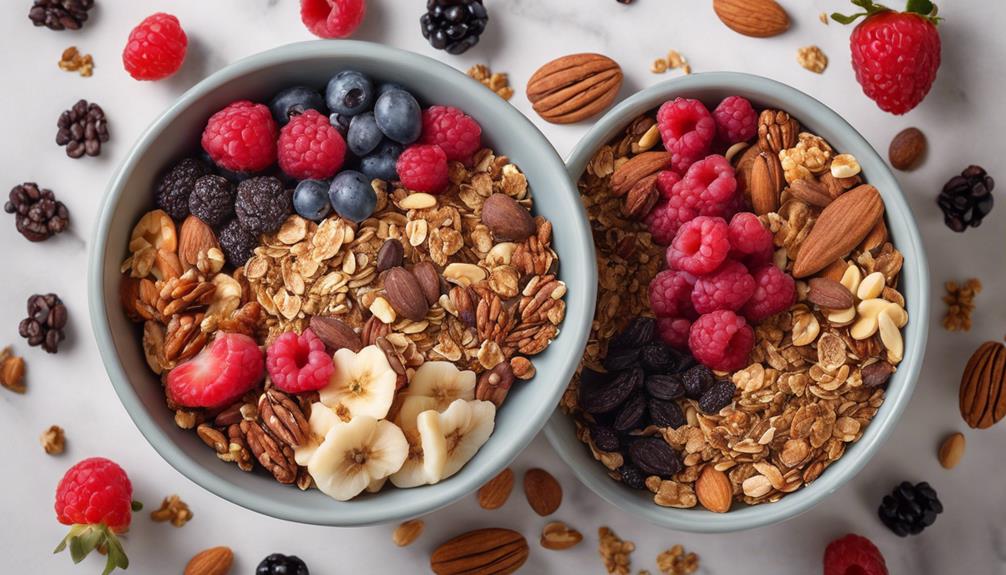
When craving a satisfying crunch with a nutrient-rich boost, cacao nib snacks are a delicious and guilt-free option. Incorporating cacao nibs into snack recipes like energy bars or protein balls not only adds a delightful chocolatey flavor but also provides a wealth of benefits.
These snacks are popular for their high levels of antioxidants, fiber, and magnesium, making them a nourishing choice for a quick bite. The best part? They offer a convenient on-the-go energy boost without the need for any baking.
For a satisfying treat, consider making cacao nib clusters with nuts or fruit, creating a delightful combination of flavors and textures. If you're looking for a guilt-free indulgence, chocolate bars with cacao nibs are a fantastic choice. By using cacao nibs instead of traditional chocolate, you can enjoy that rich chocolate taste without the added sugars.
Next time you're feeling peckish, reach for a cacao nib snack and treat yourself to a wholesome and delicious nibble.
Buying and Storing Tips
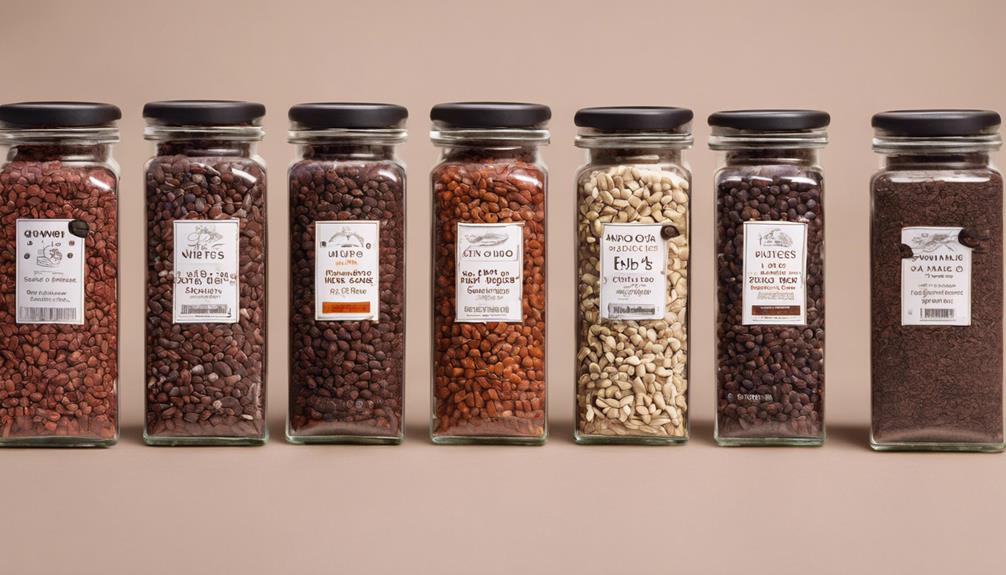
To guarantee top quality and freshness, it's essential to choose reputable suppliers when buying cacao nibs. When it comes to storing these delicate treats, here are some essential tips to keep them at their best:
- Opt for Reputable Suppliers: Make sure you purchase cacao nibs from trusted sources to guarantee their freshness and quality.
- Store Properly: Keep your cacao nibs in a cool, dark place within an airtight container to preserve their flavor and texture.
- Check Expiration Dates: Always verify the expiration dates on cacao nib packages to ensure you enjoy them at their peak freshness.
- Preserve Antioxidant Properties: Proper storage not only maintains the flavor but also helps protect the antioxidant properties and nutritional value of cacao nibs.
Frequently Asked Questions
What Can I Do With Cacao Nibs?
I love to use cacao nibs in my recipes! They add a rich, chocolatey flavor and are packed with antioxidants. I sprinkle them on yogurt, blend them in smoothies, and even mix them into baked goods for a delicious treat.
Is It OK to Eat Cacao Nibs Everyday?
Eating cacao nibs daily is beneficial for most, providing antioxidants and nutrients. Crucial is important due to natural stimulants. Consult a healthcare provider if sensitive to caffeine or certain health conditions. Enjoy in various meals!
Can Cacao Nibs Go Rancid?
Yes, cacao nibs can go rancid if not stored properly. Heat, light, and moisture speed up the process. Checking expiration dates and storing them in a cool, dark place is essential. Airtight containers maintain freshness.
Are Cacao Nibs High in Caffeine?
Not a coffee jolt, cacao nibs offer a gentle lift with minimal caffeine, about 1-15 milligrams per ounce. Enjoy their benefits without worrying about a caffeine rush. It's like a slow dance, not a sprint.
Can I Use Cacao Nibs in This Decadent Cacao Dessert Recipe?
Yes, you can absolutely use cacao nibs in this decadent cacao dessert recipe. Cacao nibs will add a rich, intense chocolate flavor and a satisfying crunch to your dessert. Incorporating them will take your decadent cacao dessert recipe to the next level of indulgence.
Conclusion
To sum up, cacao nibs are a versatile ingredient that can be used in a variety of delicious recipes. Whether you're looking to add a crunchy texture to your breakfast yogurt or create a rich chocolatey dessert, cacao nibs are the perfect addition.
So next time you're in the kitchen, don't forget to grab a bag of cacao nibs and get creative with your cooking. Remember, the possibilities are as endless as the stars in the sky!

